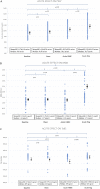Differential effects of heat-not-burn and conventional cigarettes on coronary flow, myocardial and vascular function
- PMID: 34083663
- PMCID: PMC8175445
- DOI: 10.1038/s41598-021-91245-9
Differential effects of heat-not-burn and conventional cigarettes on coronary flow, myocardial and vascular function
Abstract
We compared the effects of Heat-not-Burn cigarette (HNBC) to those of tobacco cigarette (Tcig), on myocardial, coronary and arterial function as well as on oxidative stress and platelet activation in 75 smokers. In the acute study, 50 smokers were randomised into smoking a single Tcig or a HNBC and after 60 min were crossed-over to the alternate smoking. For chronic phase, 50 smokers were switched to HNBC and were compared with an external group of 25 Tcig smokers before and after 1 month. Exhaled carbon monoxide (CO), pulse wave velocity (PWV), malondialdehyde (MDA) and thromboxane B2 (TxB2) were assessed in the acute and chronic study. Global longitudinal strain (GLS), myocardial work index (GWI), wasted myocardial work (GWW), coronary flow reserve (CFR), total arterial compliance (TAC) and flow-mediated dilation (FMD) were assessed in the chronic study. Acute HNBC smoking caused a smaller increase of PWV than Tcig (change 1.1 vs 0.54 m/s, p < 0.05) without change in CO and biomarkers in contrast to Tcig. Compared to Tcig, switching to HNBC for 1-month improved CO, FMD, CFR, TAC, GLS, GWW, MDA, TxB2 (differences 10.42 ppm, 4.3%, 0.98, 1.8 mL/mmHg, 2.35%, 19.72 mmHg%, 0.38 nmol/L and 45 pg/mL respectively, p < 0.05). HNBCs exert a less detrimental effect on vascular and cardiac function than tobacco cigarettes.Trial registration Registered on https://clinicaltrials.gov/ (NCT03452124, 02/03/2018).
Conflict of interest statement
The authors declare no competing interests.
Figures





Similar articles
-
Acute Effects of Heat-Not-Burn, Electronic Vaping, and Traditional Tobacco Combustion Cigarettes: The Sapienza University of Rome-Vascular Assessment of Proatherosclerotic Effects of Smoking ( SUR - VAPES ) 2 Randomized Trial.J Am Heart Assoc. 2019 Mar 19;8(6):e010455. doi: 10.1161/JAHA.118.010455. J Am Heart Assoc. 2019. PMID: 30879375 Free PMC article. Clinical Trial.
-
A randomized trial comparing the acute coronary, systemic, and environmental effects of electronic vaping cigarettes versus heat-not-burn cigarettes in smokers of combustible cigarettes undergoing invasive coronary assessment: rationale and design of the SUR-VAPES 3 trial.Minerva Cardioangiol. 2020 Dec;68(6):548-555. doi: 10.23736/S0026-4725.20.05181-6. Epub 2020 Jun 2. Minerva Cardioangiol. 2020. PMID: 32492988 Clinical Trial.
-
Impact of heat-not-burn cigarette passive smoking on children's oxidative stress, endothelial and platelet function.Environ Pollut. 2024 Mar 15;345:123304. doi: 10.1016/j.envpol.2024.123304. Epub 2024 Jan 29. Environ Pollut. 2024. PMID: 38295930
-
Profiling the Acute Effects of Modified Risk Products: Evidence from the SUR-VAPES (Sapienza University of Rome-Vascular Assessment of Proatherosclerotic Effects of Smoking) Cluster Study.Curr Atheroscler Rep. 2020 Feb 7;22(2):8. doi: 10.1007/s11883-020-0824-4. Curr Atheroscler Rep. 2020. PMID: 32034541 Review.
-
Vaping Cardiovascular Health Risks: an Updated Umbrella Review.Curr Emerg Hosp Med Rep. 2020;8(3):103-109. doi: 10.1007/s40138-020-00219-0. Epub 2020 Jun 16. Curr Emerg Hosp Med Rep. 2020. PMID: 32837803 Free PMC article. Review.
Cited by
-
Differential effects of heat-not-burn, electronic, and conventional cigarettes on endothelial glycocalyx.Eur Heart J Imaging Methods Pract. 2023 Jul 7;1(1):qyad008. doi: 10.1093/ehjimp/qyad008. eCollection 2023 May. Eur Heart J Imaging Methods Pract. 2023. PMID: 39044785 Free PMC article. No abstract available.
-
A scoping review of the toxicity and health impact of IQOS.Tob Induc Dis. 2024 Jun 3;22. doi: 10.18332/tid/188867. eCollection 2024. Tob Induc Dis. 2024. PMID: 38832049 Free PMC article.
-
Sex-Related Differences in Oxidative, Platelet, and Vascular Function in Chronic Users of Heat-not-Burn vs. Traditional Combustion Cigarettes.Antioxidants (Basel). 2022 Jun 24;11(7):1237. doi: 10.3390/antiox11071237. Antioxidants (Basel). 2022. PMID: 35883727 Free PMC article.
-
[Addictive inhalants-A challenge for the lungs].Pneumologe (Berl). 2022;19(1):49-59. doi: 10.1007/s10405-021-00428-8. Epub 2022 Jan 4. Pneumologe (Berl). 2022. PMID: 35002591 Free PMC article. German.
-
Nicotine from a Different Angle: Biological Effects from a Psychoneuroimmunological Perspective.Int J Mol Sci. 2025 Jul 4;26(13):6437. doi: 10.3390/ijms26136437. Int J Mol Sci. 2025. PMID: 40650213 Free PMC article. Review.
References
-
- Piepoli MF, et al. 2016 European Guidelines on cardiovascular disease prevention in clinical practice: The Sixth Joint Task Force of the European Society of Cardiology and Other Societies on Cardiovascular Disease Prevention in Clinical Practice (constituted by representatives of ten societies and by invited experts) Developed with the special contribution of the European Association for Cardiovascular Prevention & Rehabilitation (EACPR) Eur. Heart J. 2016;37:2315–2381. doi: 10.1093/eurheartj/ehw106. - DOI - PMC - PubMed
-
- Farsalinos K, Tsiapras D, Kyrzopoulos S, Voudris V. Acute and chronic effects of smoking on myocardial function in healthy heavy smokers: A study of Doppler flow, Doppler tissue velocity, and two-dimensional speckle tracking echocardiography. Echocardiography. 2013;30:285–292. doi: 10.1111/echo.12052. - DOI - PubMed
Publication types
MeSH terms
Substances
Associated data
LinkOut - more resources
Full Text Sources
Medical
Miscellaneous

